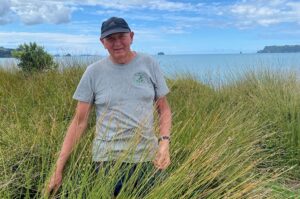Ten new nurses have been approved for Thames Hospital’s emergency department as Te Whatu Ora moves to address its chronic understaffing issues. But although staff are “ecstatic” over the win, they say they will still be well short of approximately 44 staff needed to manage their workload safely.
Currently, the department has only 21.51 full-time equivalent (FTE) nursing roles on its roster. Even with 10 more nurses, it will still need an additional 12.29 FTE roles.
ED nurse and NZ Nurses Organisation delegate Elizabeth Brundrit said working conditions had been unsustainable for some time, putting patients at risk.
“[The recommended] one-to-four patient ratio in emergency departments… we well exceed that,” she said, adding that ratios often were as high as one-to-nine, or one-to-18 if staff took a break.
“Our matrix for night shift is only two nurses – a break on night shift is a bit of a luxury. It’s stressful because you’re constantly concerned that you’ll miss something or you’re wanting to get back and care for the patients in the waiting room, but you can’t. And that’s very scary. You feel like you’re not doing a sufficient job.”
In April the department underwent an analysis of patient data through workplace management software Tendcare, one of the last health departments in Waikato to do so. The data showed it needed 43.8 FTE nurses in order to operate safely – a more than 100 per cent increase on current staff numbers. Elizabeth said the nurses were thrilled with the analysis, and welcomed an end to the strain of understaffing.
However in June, Te Whatu Ora announced a hiring freeze. Despite the freeze ostensibly applying only to non-patient-facing roles, Thames ED found itself unable to recruit.
“To go through it all, to tick all the boxes that we need to do, and then at the end we’re told no… It’s very deflating for our nurses,” Elizabeth said.
“We understand there are some budget cuts, [but] the staff, they’re exhausted.”

Elizabeth and the other nurse delegates have worked tirelessly to get some concessions from Te Whatu Ora. They organised a picket outside the hospital on July 30, highlighting the unsafe working conditions of the department. They also sent letters, one to Te Whatu Ora’s new commissioner Professor Lester Levy and one to Waikato group director of operations Michelle Sutherland, highlighting the issues.
“Health New Zealand’s primary duty of care [is to] ensure the health, safety and wellbeing of workers… You are failing in this duty,” one of the letters read.
“We are continuously rationing care, which has potential to lead to patient harm and clinical errors.”
Elizabeth agreed, saying nurses were even having to cover multiple roles in one shift.
“We’re having to prioritise the triage because the sickest patient in our department is a patient that’s not been seen at all because they could have any issue,” she said.
“You can’t then prioritise patients in the waiting room. It’s just too big a role for one nurse. And because [the nurses] don’t get as far as the waiting room, that then also increases the length of patient stays because we can’t go and pre-do bloods or pre-order certain x-rays or give pain relief. Patients can deteriorate in our waiting room without being seen.”
Thames ED staff received a letter in reply from Michelle Sutherland on September 4, saying she was pleased to confirm the additional staff, and hoped it would “go some way to reducing the workload of staff and to provide quality and safe care to patients”.
Te Whatu Ora Waikato’s acting group director of operations and chief nurse Sue Hayward told The Profile she and Michelle Sutherland met with Thames nursing staff last month to discuss their concerns.
“This allocation will support recruitment of extra nursing staff to be allocated to shifts at the hospital and enable improved night duty cover and a dedicated triage nurse. A budget increase for health care assistants has also been approved, which will further support nursing workload.”
The changes mean staff can now begin to address a number of health and safety issues caused by the understaffing, such as a lack of breaks on night shifts, inadequate monitoring of patients, and long waiting times.
However, Elizabeth said the battle wasn’t over.
“We’ve had 10 nurses approved and that’s in writing, which is fantastic,” she said.
“We’re all ecstatic, it’s a huge win for Thames. This is going to make such a difference to patient care, to staff. [But] it’s a partial win, we’ve still a long way to go.”
The issues at Thames Hospital’s emergency department are far from uncommon. New Zealand Nurses Organisation’s Waikato organiser Nigel Dawson said Waikato Hospital’s emergency department was also struggling.
“Waikato ED had their calculations done at the same time [as Thames], so they’re short staffed but they’re nowhere near as dire as Thames was,” he said.
“There’s still no general recruitment available at all. The hiring freeze that nobody will admit to is still going on… [Te Whatu Ora] have just last week allowed for maternity leave cover to be recruited to. Maternity leave, long-term ACC, basically any absences weren’t available to be recruited to, but the maternity one has changed. Obviously with a predominantly female workforce for nursing that’s a big issue.”
Meanwhile, Elizabeth said she would be returning to her delegate role with renewed energy.
“Us four delegates that have been in Thames have fought so hard to get this far…we’re all obviously so pleased,” she said.
“It’s not management, it’s us who’ve made the change. We’ve had multiple meetings a week, there’s so much we’ve done in our own time to get this. And we’ve done it for everybody – the community, for ourselves, for all of us. It’s a very good win and it’s going to make a significant change.”





